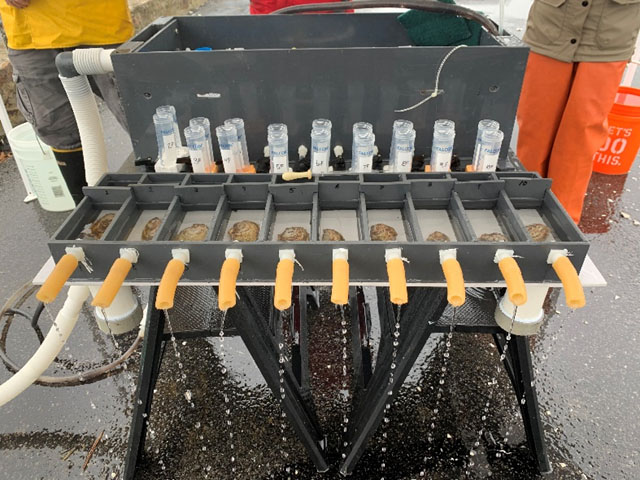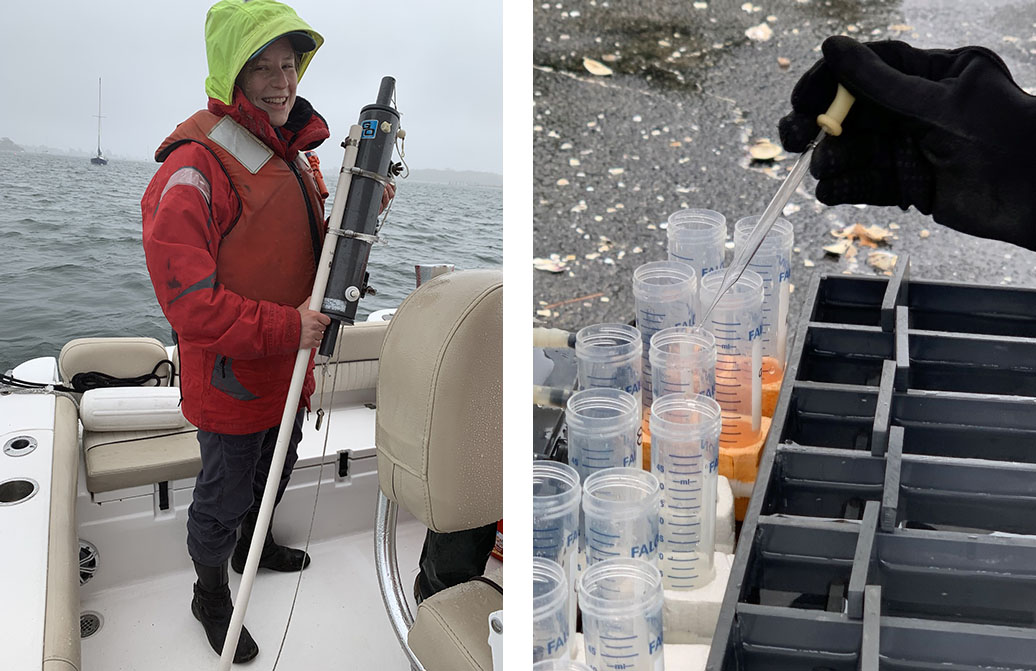Burning fossil fuel, applying fertilizers, and other activities have resulted in nutrient-loaded runoff that can cause the overgrowth of algae and seaweeds in coastal waters such as Greenwich Harbor. This excessive plant material has been linked to environmental problems like algal blooms and low dissolved oxygen. Coastal resource managers are looking at oyster aquaculture as a way to improve water quality, since oysters feed by filtering algae from the water, which, ultimately, removes nutrients from the water when the oysters are harvested. We are measuring oyster retention of nutrients in the lab and in the field to improve the accuracy of models that estimate oyster-related nutrient removal and help guide coastal managers.
Why We Care
About 65 percent of U.S. estuaries and coastal waterbodies have moderate to high levels of nutrients due to excessive land-based inputs from human activities, including burning fossil fuels, fertilizing farms and lawns, and operating concentrated animal feed lots. Oysters can improve water quality because their filter-feeding action removes nutrient-laden particulates (i.e., algae and detritus) from the water. They incorporate some of these nutrients into their tissues and shells as they grow. Recently, the U.S. Environmental Protection Agency approved the use of oysters and clams to remove nutrients from two northeastern U.S. waterbodies, and the Chesapeake Bay Program has approved the use of harvested oyster tissue as a nutrient best management practice.
The nutrient removal associated with oyster harvest can be estimated by multiplying the nutrient content of an oyster by the number of oysters harvested. For example, in Chesapeake Bay, harvest of one million oysters is equivalent to removing 198 pounds of nitrogen and 22 pounds of phosphorus. This approach underestimates total farm nutrient removal, because it fails to take into account the filtration activities of the oysters too small to harvest. Another way to estimate removal capabilities is by using models that mimic the growth of oysters and their retention of nutrients based on measurements of variables that influence oyster growth, such as temperature, salinity, and food concentration (algae and detritus), and detailed measurements of the physiological responses of oysters to those variables. The benefit of using these models is that harvest and nutrient removal can be simulated for whole farms, as well as for different cultivation scenarios, such as expansion of a farm, without the cost or time to implement a farm. Thus, management programs can more efficiently plan how to use oysters with other nutrient reduction measures to achieve water quality goals. In areas where there are no pathogenic or toxic chemical contaminants, these models can also be used to estimate oyster harvest for consumption, a win-win for domestic sustainable seafood production and water quality improvement.
What We Are Doing

To adequately serve nutrient management programs, marine spatial planning, and aquaculture development efforts, the models must provide accurate oyster growth and nutrient retention estimates. Our project, funded by NOAA’s Office of Aquaculture, uses the Farm Aquaculture Resource Management (FARM) Model to estimate harvest and nitrogen removal at the farm scale. Local-level results can be scaled up to all farms within a waterbody to provide information about the full potential of the aquaculture industry to improve water quality. Project partners are working to collect data needed to update and validate the FARM model for nitrogen removal by the Eastern oyster (Crassostrea virginica) off the coast of Greenwich, Connecticut, in Long Island Sound.
Updates to the FARM model include making the same changes to the model to match harvest end-points, growth patterns, and reproductive behavior for Long Island Sound that have already been added to the FARM model that was calibrated to Chesapeake Bay locations. These changes include limitation of food ingestion by establishing a maximum gut capacity and time needed for food particles to pass through the gut to prevent overgrowth of the oysters by the model. Additionally, the model increases the production of pseudofaeces when food reaches a specific (high) threshold. For diploid oysters, the modelers have added an equation that more accurately simulates spawning, since diploid oysters are “trickle spawners” and can spawn more than one time per year. Thus, a capability has been added that takes into account the temperature and oyster condition and will allow, given that criteria are met, multiple spawning events per year. These changes to the model will be implemented, as appropriate, to more accurately simulate growth and nutrient removal by oysters in the coastal waters off Greenwich, Connecticut.
Project partners are collecting monthly environmental data that are needed inputs to the Long Island Sound–calibrated version of the FARM model (i.e., water temperature, salinity, dissolved oxygen, chlorophyll, total particulate matter, particulate organic matter, and current speed). Additionally, monthly data on the carbon:nitrogen ratio of seston, oyster size and total fresh weight, tissue and shell dry weight, nitrogen content of oyster tissue and shell are being collected for validation of the oyster growth cycle and to improve model simulation of nitrogen removal. Project scientists will also determine biodeposit production and excretion rates for Greenwich oysters to calculate the fraction of nitrogen lost prior to assimilation within the model. The environmental data and oyster growth measurements will be used to verify the simulation of biomass production at the individual level in the updated model. The individual model will be incorporated into the FARM model to predict population level harvest yields of the Stella Mar Oysters partner. In parallel, experimental results on nitrogen dynamics will be used to improve parameterization of nitrogen uptake and loss rates, including during pre-ingestive selection and in the gut, to obtain a more accurate description of all nitrogen dynamics within the model.

Benefits of Our Work
These updates will expand the utility of the model within a larger marine spatial planning context. The project will provide coastal managers with a better understanding of oysters’ nutrient removal capabilities, which, in turn, will be used to optimize marine spatial planning and aquaculture development efforts, especially in waterbodies that require nutrient management. With improvements in predictive ability of nitrogen removal, planners and resource managers will be able to make informed decisions about expansion of the aquaculture industry into areas that could further benefit from the water quality improvements that shellfish aquaculture provides.
The project team includes northeast U.S. state shellfish managers, as well as representatives from federal nutrient management programs, LongLine Environment, Ltd. (a modeling partner), and Stella Mar Oysters (a partner from the aquaculture industry). We anticipate that this approach will be useful in other waterbodies that require additional nutrient management and also support oyster populations.
Next Steps
Team members will provide NOAA staff with connections for targeted dissemination of results to interested parties and appropriate stakeholder groups. Those groups will use the model to evaluate different oyster aquaculture expansion scenarios and the potential benefits to seafood production and water quality improvement.
